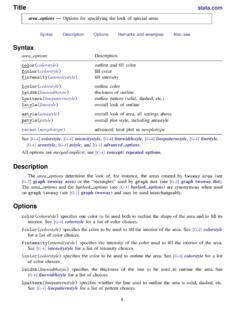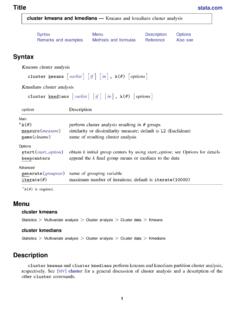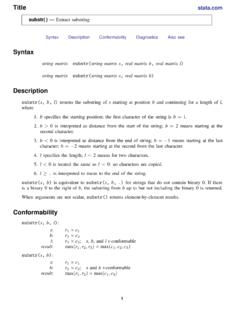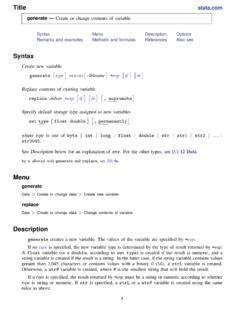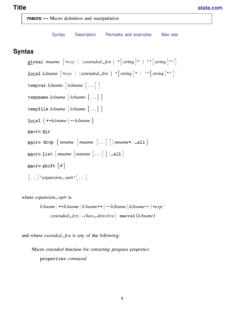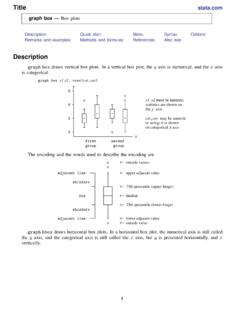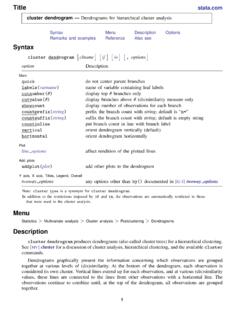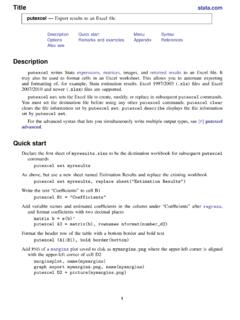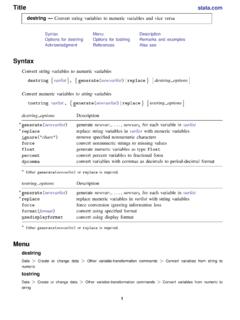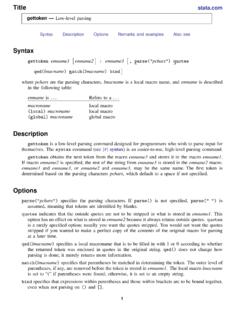Transcription of tabulate, summarize() — One- and two-way tables of …
1 Title tabulate, summarize() One- and two-way tables of summary statistics Syntax Menu Description Options Remarks and examples Also see Syntax . tabulate varname1 varname2 if in weight , options options Description Main summarize(varname3 ) report summary statistics for varname3.. no means include or suppress means . no standard include or suppress standard deviations . no freq include or suppress frequencies . no obs include or suppress number of observations nolabel show numeric codes, not labels wrap do not break wide tables missing treat missing values of varname1 and varname2 as categories by is allowed; see [D] by. aweights and fweights are allowed; see [U] weight. Menu Statistics > Summaries, tables , and tests > Other tables > table of means, std. dev., and frequencies Description tabulate, summarize() produces one- and two-way tables (breakdowns) of means and standard deviations.
2 See [R] tabulate oneway and [R] tabulate twoway for one- and two-way frequency tables . See [R] table for a more flexible command that produces one-, two-, and n-way tables of frequencies and a wide variety of summary statistics. table is better, but tabulate, summarize() is faster. Also see [R] tabstat for yet another alternative. Options . Main summarize(varname3 ) identifies the name of the variable for which summary statistics are to be reported. If you do not specify this option, a table of frequencies is produced; see [R] tabulate oneway and [R] tabulate twoway. The description here concerns tabulate when this option is specified. 1. 2 tabulate, summarize() One- and two-way tables of summary statistics [no]means includes or suppresses only the means from the table . The summarize() table normally includes the mean, standard deviation, frequency, and, if the data are weighted, number of observations.
3 Individual elements of the table may be included or suppressed by the [no]means, [no]standard, [no]freq, and [no]obs options. For example, typing . tabulate category, summarize(myvar) means standard produces a summary table by category containing only the means and standard deviations of myvar. You could also achieve the same result by typing . tabulate category, summarize(myvar) nofreq [no]standard includes or suppresses only the standard deviations from the table ; see [no]means option above. [no]freq includes or suppresses only the frequencies from the table ; see [no]means option above. [no]obs includes or suppresses only the reported number of observations from the table . If the data are not weighted, the number of observations is identical to the frequency, and by default only the frequency is reported.
4 If the data are weighted, the frequency refers to the sum of the weights. See [no]means option above. nolabel causes the numeric codes to be displayed rather than the label values. wrap requests that no action be taken on wide tables to make them readable. Unless wrap is specified, wide tables are broken into pieces to enhance readability. missing requests that missing values of varname1 and varname2 be treated as categories rather than as observations to be omitted from the analysis. Remarks and examples tabulate with the summarize() option produces one- and two-way tables of summary statistics. When combined with the by prefix, it can produce n-way tables as well. Remarks are presented under the following headings: One-way tables two-way tables One-way tables Example 1. We have data on 74 automobiles.
5 Included in our dataset are the variables foreign, which marks domestic and foreign cars, and mpg, the car's mileage rating. Typing tabulate foreign displays a breakdown of the number of observations we have by the values of the foreign variable.. use (1978 Automobile Data).. tabulate foreign Car type Freq. Percent Cum. Domestic 52 Foreign 22 Total 74 tabulate, summarize() One- and two-way tables of summary statistics 3. We discover that we have 52 domestic cars and 22 foreign cars in our dataset. If we add the summarize(varname) option, however, tabulate produces a table of summary statistics for varname: . tabulate foreign, summarize(mpg). summary of Mileage (mpg). Car type Mean Std. Dev. Freq. Domestic 52. Foreign 22. Total 74. We also discover that the average gas mileage for domestic cars is about 20 mpg and the average foreign is almost 25 mpg.
6 Overall, the average is 21 mpg in our dataset. Technical note We might now wonder if the difference in gas mileage between foreign and domestic cars is statistically significant. We can use the oneway command to find out; see [R] oneway. To obtain an analysis-of-variance table of mpg on foreign, we type . oneway mpg foreign Analysis of Variance Source SS df MS F Prob > F. Between groups 1 Within groups 72 Total 73 Bartlett's test for equal variances: chi2(1) = Prob>chi2 = The F statistic is , and the difference between foreign and domestic cars' mileage ratings is significant at the level. There are several ways that we could have statistically compared mileage ratings see, for instance, [R] anova, [R] oneway, [R] regress, and [R] ttest but oneway seemed the most convenient. two-way tables Example 2.
7 Tabulate, summarize can be used to obtain two-way as well as one-way breakdowns. For instance, we obtained summary statistics on mpg decomposed by foreign by typing tabulate foreign, summarize(mpg). We can specify up to two variables before the comma: 4 tabulate, summarize() One- and two-way tables of summary statistics . generate wgtcat = autocode(weight,4,1760,4840).. tabulate wgtcat foreign, summarize(mpg). Means, Standard Deviations and Frequencies of Mileage (mpg). Car type wgtcat Domestic Foreign Total 2530 7 16 23. 3300 16 5 21. 4070 14 0 23 1 24. 4840 .. 6 0 6. Total 52 22 74. In addition to the means, standard deviations, and frequencies for each weight mileage cell, also reported are the summary statistics by weight, by mileage, and overall. For instance, the last row of the table reveals that the average mileage of domestic cars is and that of foreign cars is domestic cars yield poorer mileage than foreign cars.
8 But we now see that domestic cars yield better gas mileage within weight class the reason domestic cars yield poorer gas mileage is because they are, on average, heavier. Example 3. If we do not specify the statistics to be included in a table , tabulate reports the mean, standard deviation, and frequency. We can specify the statistics that we want to see using the means, standard, and freq options: . tabulate wgtcat foreign, summarize(mpg) means Means of Mileage (mpg). Car type wgtcat Domestic Foreign Total 2530 3300 4070 14 4840 . Total When we specify one or more of the means, standard, and freq options, only those statistics are displayed. Thus we could obtain a table containing just the means and standard deviations by typing means standard after the summarize(mpg) option. We can also suppress selected statistics by placing no in front of the option name.
9 Another way of obtaining only the means and standard deviations is to add the nofreq option: tabulate, summarize() One- and two-way tables of summary statistics 5.. tabulate wgtcat foreign, summarize(mpg) nofreq Means and Standard Deviations of Mileage (mpg). Car type wgtcat Domestic Foreign Total 2530 3300 4070 14 0 4840 .. Total Also see [R] table Flexible table of summary statistics [R] tabstat Compact table of summary statistics [R] tabulate oneway One-way table of frequencies [R] tabulate twoway two-way table of frequencies [D] collapse Make dataset of summary statistics [SVY] svy: tabulate oneway One-way tables for survey data [SVY] svy: tabulate twoway two-way tables for survey data [U] Dataset, variable, and value labels [U] 25 Working with categorical data and factor variables
